Tesco Employee Motivation: A Case Study Analysis and Strategies
VerifiedAdded on 2023/06/08
|10
|3084
|433
Report
AI Summary
This report provides a comprehensive analysis of motivation and its impact on employee performance, using Tesco as a case study. It begins with an introduction to the concept of motivation, its background, aim, objectives, and rationale. The literature review explores the concept of motivation, its importance within organizations, and its direct impact on employee performance, referencing various authors and studies. The research methodology section details the research type (qualitative), research approach (inductive), data collection methods (survey), data analysis techniques, and ethical considerations. The report aims to understand how motivation strategies affect Tesco employees and recommends appropriate techniques for improvement, ultimately contributing to the understanding of motivation's critical role in organizational success. Desklib provides access to this and many other solved assignments.
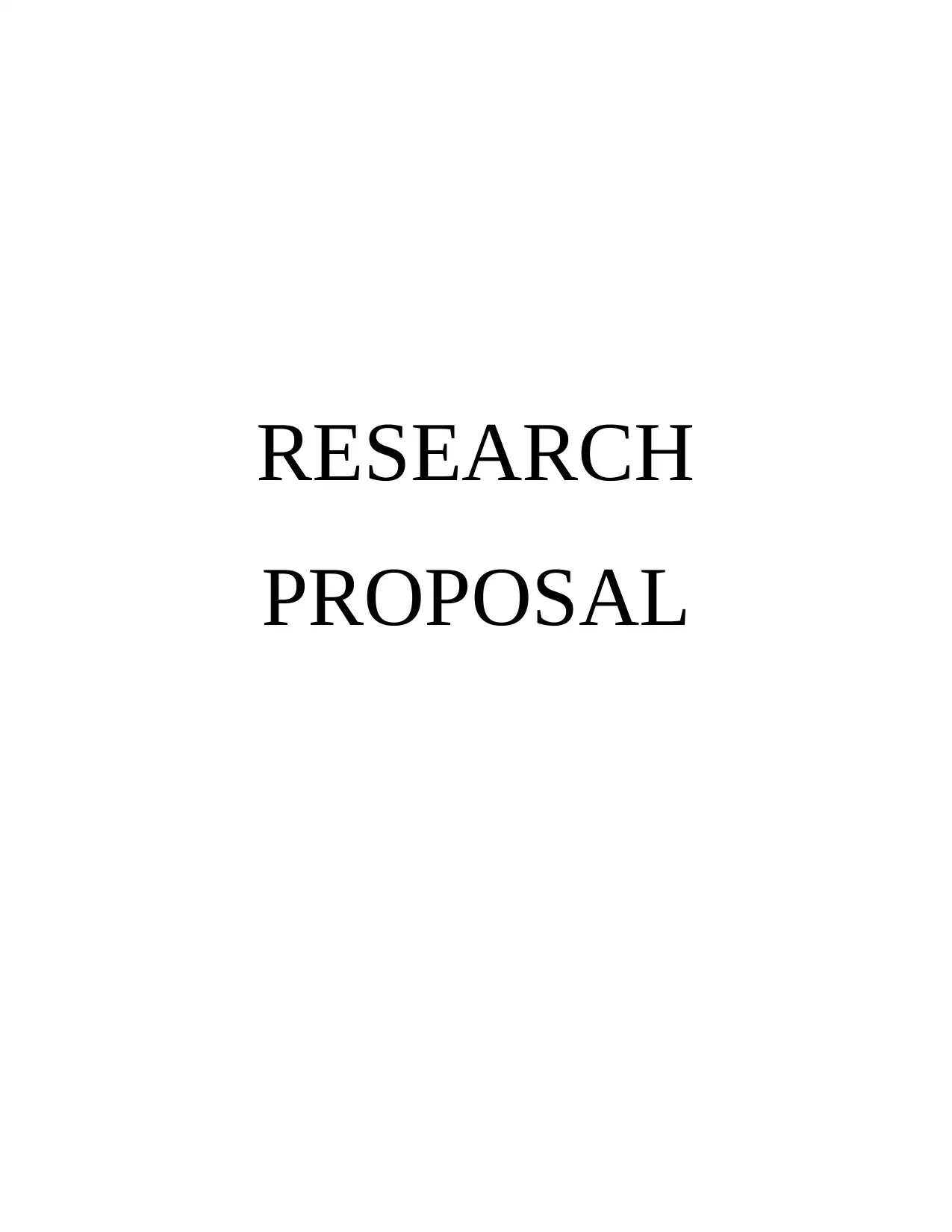
RESEARCH
PROPOSAL
PROPOSAL
Paraphrase This Document
Need a fresh take? Get an instant paraphrase of this document with our AI Paraphraser

TABLE OF CONTENTS
INTRODUCTION...........................................................................................................................3
Background..................................................................................................................................3
Aim..............................................................................................................................................3
Objectives....................................................................................................................................3
Rationale......................................................................................................................................3
LITERATURE REVIEW................................................................................................................4
Theme 1: The concept of motivation...........................................................................................4
Theme 2: The importance of motivation within an organization................................................4
Theme 3: Impact of motivation on employee performance.........................................................5
RESEARCH METHODOLOGY.....................................................................................................6
Research type...............................................................................................................................6
Research approach.......................................................................................................................7
Data collection.............................................................................................................................7
Survey..........................................................................................................................................7
Data analysis................................................................................................................................8
Ethical consideration....................................................................................................................8
CONCLUSION................................................................................................................................9
REFERENCES..............................................................................................................................10
INTRODUCTION...........................................................................................................................3
Background..................................................................................................................................3
Aim..............................................................................................................................................3
Objectives....................................................................................................................................3
Rationale......................................................................................................................................3
LITERATURE REVIEW................................................................................................................4
Theme 1: The concept of motivation...........................................................................................4
Theme 2: The importance of motivation within an organization................................................4
Theme 3: Impact of motivation on employee performance.........................................................5
RESEARCH METHODOLOGY.....................................................................................................6
Research type...............................................................................................................................6
Research approach.......................................................................................................................7
Data collection.............................................................................................................................7
Survey..........................................................................................................................................7
Data analysis................................................................................................................................8
Ethical consideration....................................................................................................................8
CONCLUSION................................................................................................................................9
REFERENCES..............................................................................................................................10
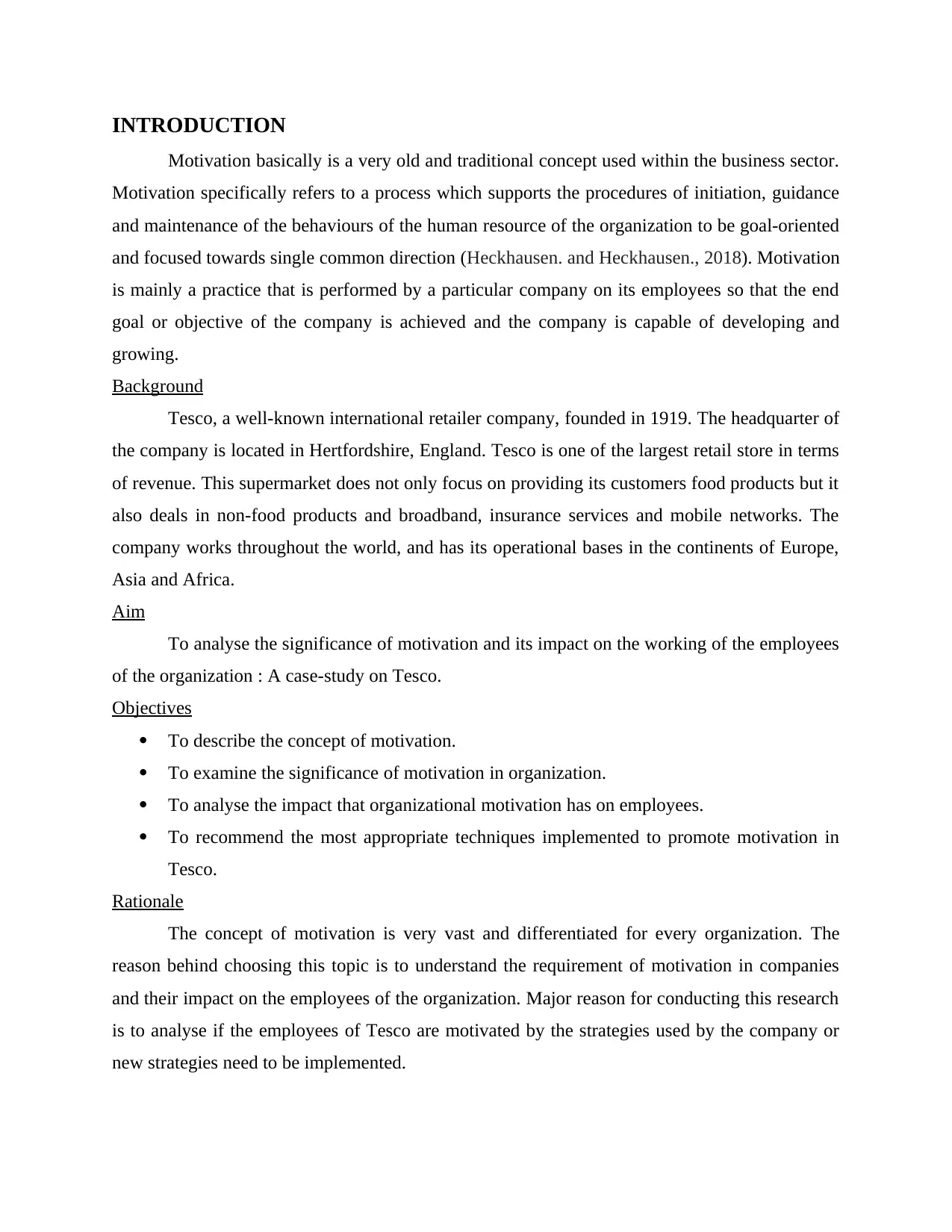
INTRODUCTION
Motivation basically is a very old and traditional concept used within the business sector.
Motivation specifically refers to a process which supports the procedures of initiation, guidance
and maintenance of the behaviours of the human resource of the organization to be goal-oriented
and focused towards single common direction (Heckhausen. and Heckhausen., 2018). Motivation
is mainly a practice that is performed by a particular company on its employees so that the end
goal or objective of the company is achieved and the company is capable of developing and
growing.
Background
Tesco, a well-known international retailer company, founded in 1919. The headquarter of
the company is located in Hertfordshire, England. Tesco is one of the largest retail store in terms
of revenue. This supermarket does not only focus on providing its customers food products but it
also deals in non-food products and broadband, insurance services and mobile networks. The
company works throughout the world, and has its operational bases in the continents of Europe,
Asia and Africa.
Aim
To analyse the significance of motivation and its impact on the working of the employees
of the organization : A case-study on Tesco.
Objectives
To describe the concept of motivation.
To examine the significance of motivation in organization.
To analyse the impact that organizational motivation has on employees.
To recommend the most appropriate techniques implemented to promote motivation in
Tesco.
Rationale
The concept of motivation is very vast and differentiated for every organization. The
reason behind choosing this topic is to understand the requirement of motivation in companies
and their impact on the employees of the organization. Major reason for conducting this research
is to analyse if the employees of Tesco are motivated by the strategies used by the company or
new strategies need to be implemented.
Motivation basically is a very old and traditional concept used within the business sector.
Motivation specifically refers to a process which supports the procedures of initiation, guidance
and maintenance of the behaviours of the human resource of the organization to be goal-oriented
and focused towards single common direction (Heckhausen. and Heckhausen., 2018). Motivation
is mainly a practice that is performed by a particular company on its employees so that the end
goal or objective of the company is achieved and the company is capable of developing and
growing.
Background
Tesco, a well-known international retailer company, founded in 1919. The headquarter of
the company is located in Hertfordshire, England. Tesco is one of the largest retail store in terms
of revenue. This supermarket does not only focus on providing its customers food products but it
also deals in non-food products and broadband, insurance services and mobile networks. The
company works throughout the world, and has its operational bases in the continents of Europe,
Asia and Africa.
Aim
To analyse the significance of motivation and its impact on the working of the employees
of the organization : A case-study on Tesco.
Objectives
To describe the concept of motivation.
To examine the significance of motivation in organization.
To analyse the impact that organizational motivation has on employees.
To recommend the most appropriate techniques implemented to promote motivation in
Tesco.
Rationale
The concept of motivation is very vast and differentiated for every organization. The
reason behind choosing this topic is to understand the requirement of motivation in companies
and their impact on the employees of the organization. Major reason for conducting this research
is to analyse if the employees of Tesco are motivated by the strategies used by the company or
new strategies need to be implemented.
⊘ This is a preview!⊘
Do you want full access?
Subscribe today to unlock all pages.

Trusted by 1+ million students worldwide
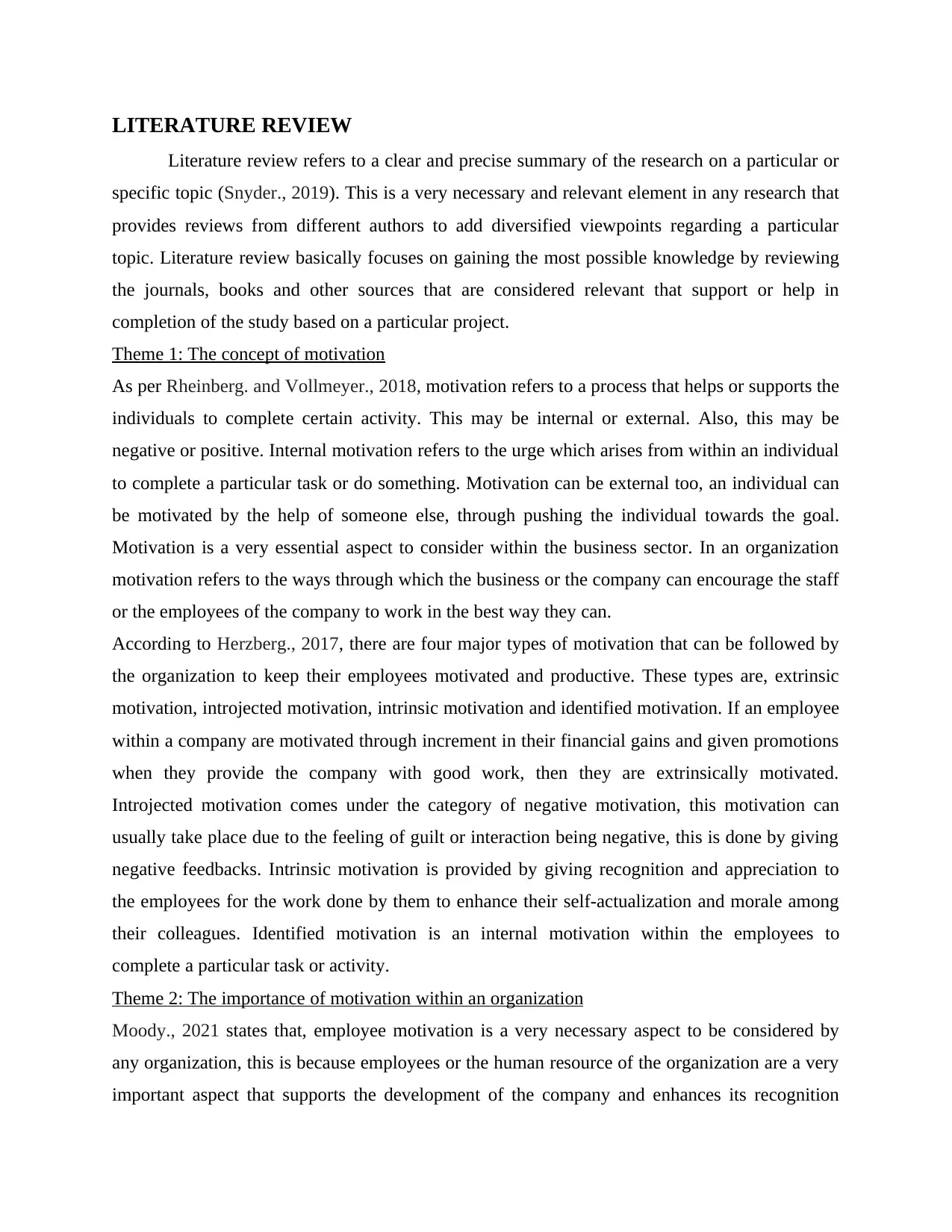
LITERATURE REVIEW
Literature review refers to a clear and precise summary of the research on a particular or
specific topic (Snyder., 2019). This is a very necessary and relevant element in any research that
provides reviews from different authors to add diversified viewpoints regarding a particular
topic. Literature review basically focuses on gaining the most possible knowledge by reviewing
the journals, books and other sources that are considered relevant that support or help in
completion of the study based on a particular project.
Theme 1: The concept of motivation
As per Rheinberg. and Vollmeyer., 2018, motivation refers to a process that helps or supports the
individuals to complete certain activity. This may be internal or external. Also, this may be
negative or positive. Internal motivation refers to the urge which arises from within an individual
to complete a particular task or do something. Motivation can be external too, an individual can
be motivated by the help of someone else, through pushing the individual towards the goal.
Motivation is a very essential aspect to consider within the business sector. In an organization
motivation refers to the ways through which the business or the company can encourage the staff
or the employees of the company to work in the best way they can.
According to Herzberg., 2017, there are four major types of motivation that can be followed by
the organization to keep their employees motivated and productive. These types are, extrinsic
motivation, introjected motivation, intrinsic motivation and identified motivation. If an employee
within a company are motivated through increment in their financial gains and given promotions
when they provide the company with good work, then they are extrinsically motivated.
Introjected motivation comes under the category of negative motivation, this motivation can
usually take place due to the feeling of guilt or interaction being negative, this is done by giving
negative feedbacks. Intrinsic motivation is provided by giving recognition and appreciation to
the employees for the work done by them to enhance their self-actualization and morale among
their colleagues. Identified motivation is an internal motivation within the employees to
complete a particular task or activity.
Theme 2: The importance of motivation within an organization
Moody., 2021 states that, employee motivation is a very necessary aspect to be considered by
any organization, this is because employees or the human resource of the organization are a very
important aspect that supports the development of the company and enhances its recognition
Literature review refers to a clear and precise summary of the research on a particular or
specific topic (Snyder., 2019). This is a very necessary and relevant element in any research that
provides reviews from different authors to add diversified viewpoints regarding a particular
topic. Literature review basically focuses on gaining the most possible knowledge by reviewing
the journals, books and other sources that are considered relevant that support or help in
completion of the study based on a particular project.
Theme 1: The concept of motivation
As per Rheinberg. and Vollmeyer., 2018, motivation refers to a process that helps or supports the
individuals to complete certain activity. This may be internal or external. Also, this may be
negative or positive. Internal motivation refers to the urge which arises from within an individual
to complete a particular task or do something. Motivation can be external too, an individual can
be motivated by the help of someone else, through pushing the individual towards the goal.
Motivation is a very essential aspect to consider within the business sector. In an organization
motivation refers to the ways through which the business or the company can encourage the staff
or the employees of the company to work in the best way they can.
According to Herzberg., 2017, there are four major types of motivation that can be followed by
the organization to keep their employees motivated and productive. These types are, extrinsic
motivation, introjected motivation, intrinsic motivation and identified motivation. If an employee
within a company are motivated through increment in their financial gains and given promotions
when they provide the company with good work, then they are extrinsically motivated.
Introjected motivation comes under the category of negative motivation, this motivation can
usually take place due to the feeling of guilt or interaction being negative, this is done by giving
negative feedbacks. Intrinsic motivation is provided by giving recognition and appreciation to
the employees for the work done by them to enhance their self-actualization and morale among
their colleagues. Identified motivation is an internal motivation within the employees to
complete a particular task or activity.
Theme 2: The importance of motivation within an organization
Moody., 2021 states that, employee motivation is a very necessary aspect to be considered by
any organization, this is because employees or the human resource of the organization are a very
important aspect that supports the development of the company and enhances its recognition
Paraphrase This Document
Need a fresh take? Get an instant paraphrase of this document with our AI Paraphraser
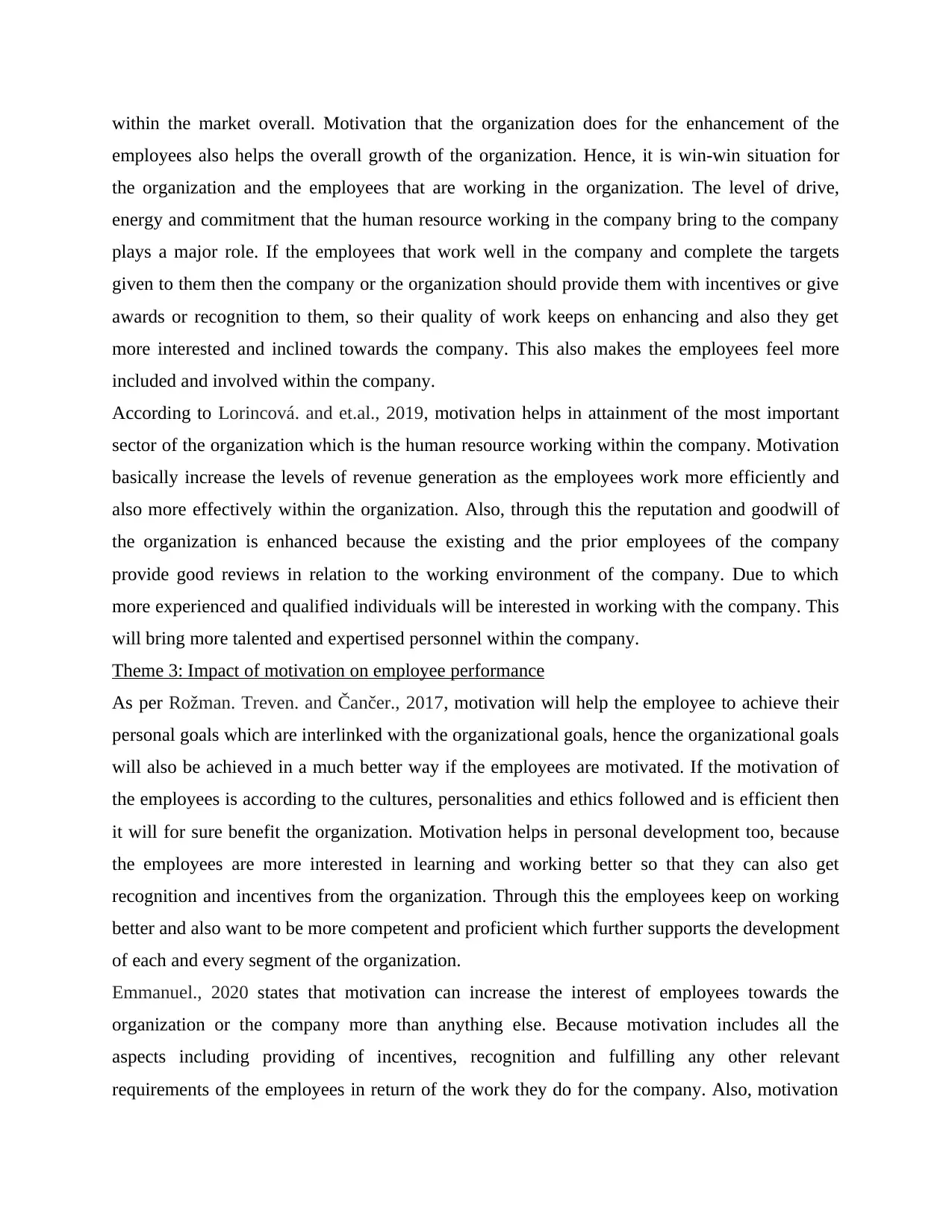
within the market overall. Motivation that the organization does for the enhancement of the
employees also helps the overall growth of the organization. Hence, it is win-win situation for
the organization and the employees that are working in the organization. The level of drive,
energy and commitment that the human resource working in the company bring to the company
plays a major role. If the employees that work well in the company and complete the targets
given to them then the company or the organization should provide them with incentives or give
awards or recognition to them, so their quality of work keeps on enhancing and also they get
more interested and inclined towards the company. This also makes the employees feel more
included and involved within the company.
According to Lorincová. and et.al., 2019, motivation helps in attainment of the most important
sector of the organization which is the human resource working within the company. Motivation
basically increase the levels of revenue generation as the employees work more efficiently and
also more effectively within the organization. Also, through this the reputation and goodwill of
the organization is enhanced because the existing and the prior employees of the company
provide good reviews in relation to the working environment of the company. Due to which
more experienced and qualified individuals will be interested in working with the company. This
will bring more talented and expertised personnel within the company.
Theme 3: Impact of motivation on employee performance
As per Rožman. Treven. and Čančer., 2017, motivation will help the employee to achieve their
personal goals which are interlinked with the organizational goals, hence the organizational goals
will also be achieved in a much better way if the employees are motivated. If the motivation of
the employees is according to the cultures, personalities and ethics followed and is efficient then
it will for sure benefit the organization. Motivation helps in personal development too, because
the employees are more interested in learning and working better so that they can also get
recognition and incentives from the organization. Through this the employees keep on working
better and also want to be more competent and proficient which further supports the development
of each and every segment of the organization.
Emmanuel., 2020 states that motivation can increase the interest of employees towards the
organization or the company more than anything else. Because motivation includes all the
aspects including providing of incentives, recognition and fulfilling any other relevant
requirements of the employees in return of the work they do for the company. Also, motivation
employees also helps the overall growth of the organization. Hence, it is win-win situation for
the organization and the employees that are working in the organization. The level of drive,
energy and commitment that the human resource working in the company bring to the company
plays a major role. If the employees that work well in the company and complete the targets
given to them then the company or the organization should provide them with incentives or give
awards or recognition to them, so their quality of work keeps on enhancing and also they get
more interested and inclined towards the company. This also makes the employees feel more
included and involved within the company.
According to Lorincová. and et.al., 2019, motivation helps in attainment of the most important
sector of the organization which is the human resource working within the company. Motivation
basically increase the levels of revenue generation as the employees work more efficiently and
also more effectively within the organization. Also, through this the reputation and goodwill of
the organization is enhanced because the existing and the prior employees of the company
provide good reviews in relation to the working environment of the company. Due to which
more experienced and qualified individuals will be interested in working with the company. This
will bring more talented and expertised personnel within the company.
Theme 3: Impact of motivation on employee performance
As per Rožman. Treven. and Čančer., 2017, motivation will help the employee to achieve their
personal goals which are interlinked with the organizational goals, hence the organizational goals
will also be achieved in a much better way if the employees are motivated. If the motivation of
the employees is according to the cultures, personalities and ethics followed and is efficient then
it will for sure benefit the organization. Motivation helps in personal development too, because
the employees are more interested in learning and working better so that they can also get
recognition and incentives from the organization. Through this the employees keep on working
better and also want to be more competent and proficient which further supports the development
of each and every segment of the organization.
Emmanuel., 2020 states that motivation can increase the interest of employees towards the
organization or the company more than anything else. Because motivation includes all the
aspects including providing of incentives, recognition and fulfilling any other relevant
requirements of the employees in return of the work they do for the company. Also, motivation
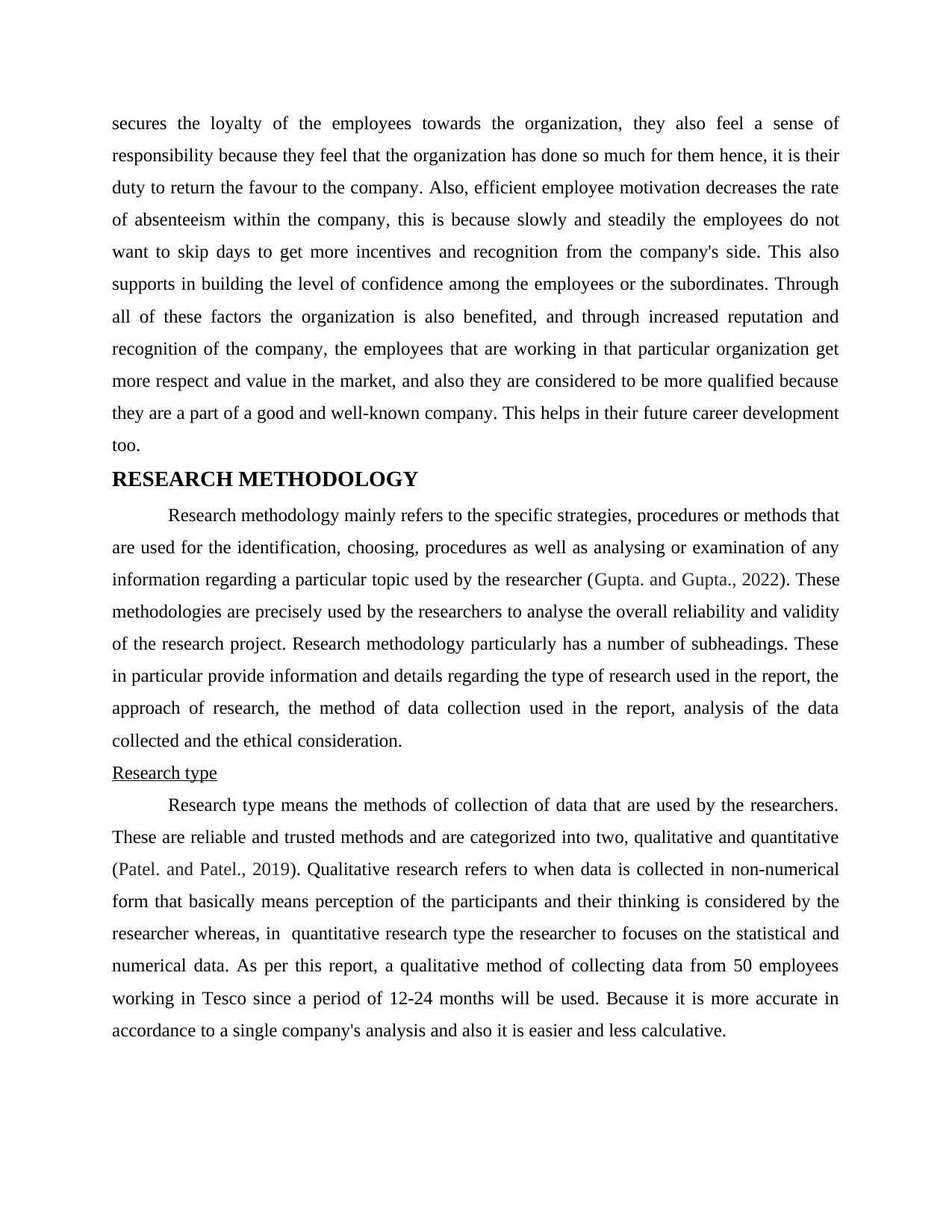
secures the loyalty of the employees towards the organization, they also feel a sense of
responsibility because they feel that the organization has done so much for them hence, it is their
duty to return the favour to the company. Also, efficient employee motivation decreases the rate
of absenteeism within the company, this is because slowly and steadily the employees do not
want to skip days to get more incentives and recognition from the company's side. This also
supports in building the level of confidence among the employees or the subordinates. Through
all of these factors the organization is also benefited, and through increased reputation and
recognition of the company, the employees that are working in that particular organization get
more respect and value in the market, and also they are considered to be more qualified because
they are a part of a good and well-known company. This helps in their future career development
too.
RESEARCH METHODOLOGY
Research methodology mainly refers to the specific strategies, procedures or methods that
are used for the identification, choosing, procedures as well as analysing or examination of any
information regarding a particular topic used by the researcher (Gupta. and Gupta., 2022). These
methodologies are precisely used by the researchers to analyse the overall reliability and validity
of the research project. Research methodology particularly has a number of subheadings. These
in particular provide information and details regarding the type of research used in the report, the
approach of research, the method of data collection used in the report, analysis of the data
collected and the ethical consideration.
Research type
Research type means the methods of collection of data that are used by the researchers.
These are reliable and trusted methods and are categorized into two, qualitative and quantitative
(Patel. and Patel., 2019). Qualitative research refers to when data is collected in non-numerical
form that basically means perception of the participants and their thinking is considered by the
researcher whereas, in quantitative research type the researcher to focuses on the statistical and
numerical data. As per this report, a qualitative method of collecting data from 50 employees
working in Tesco since a period of 12-24 months will be used. Because it is more accurate in
accordance to a single company's analysis and also it is easier and less calculative.
responsibility because they feel that the organization has done so much for them hence, it is their
duty to return the favour to the company. Also, efficient employee motivation decreases the rate
of absenteeism within the company, this is because slowly and steadily the employees do not
want to skip days to get more incentives and recognition from the company's side. This also
supports in building the level of confidence among the employees or the subordinates. Through
all of these factors the organization is also benefited, and through increased reputation and
recognition of the company, the employees that are working in that particular organization get
more respect and value in the market, and also they are considered to be more qualified because
they are a part of a good and well-known company. This helps in their future career development
too.
RESEARCH METHODOLOGY
Research methodology mainly refers to the specific strategies, procedures or methods that
are used for the identification, choosing, procedures as well as analysing or examination of any
information regarding a particular topic used by the researcher (Gupta. and Gupta., 2022). These
methodologies are precisely used by the researchers to analyse the overall reliability and validity
of the research project. Research methodology particularly has a number of subheadings. These
in particular provide information and details regarding the type of research used in the report, the
approach of research, the method of data collection used in the report, analysis of the data
collected and the ethical consideration.
Research type
Research type means the methods of collection of data that are used by the researchers.
These are reliable and trusted methods and are categorized into two, qualitative and quantitative
(Patel. and Patel., 2019). Qualitative research refers to when data is collected in non-numerical
form that basically means perception of the participants and their thinking is considered by the
researcher whereas, in quantitative research type the researcher to focuses on the statistical and
numerical data. As per this report, a qualitative method of collecting data from 50 employees
working in Tesco since a period of 12-24 months will be used. Because it is more accurate in
accordance to a single company's analysis and also it is easier and less calculative.
⊘ This is a preview!⊘
Do you want full access?
Subscribe today to unlock all pages.

Trusted by 1+ million students worldwide
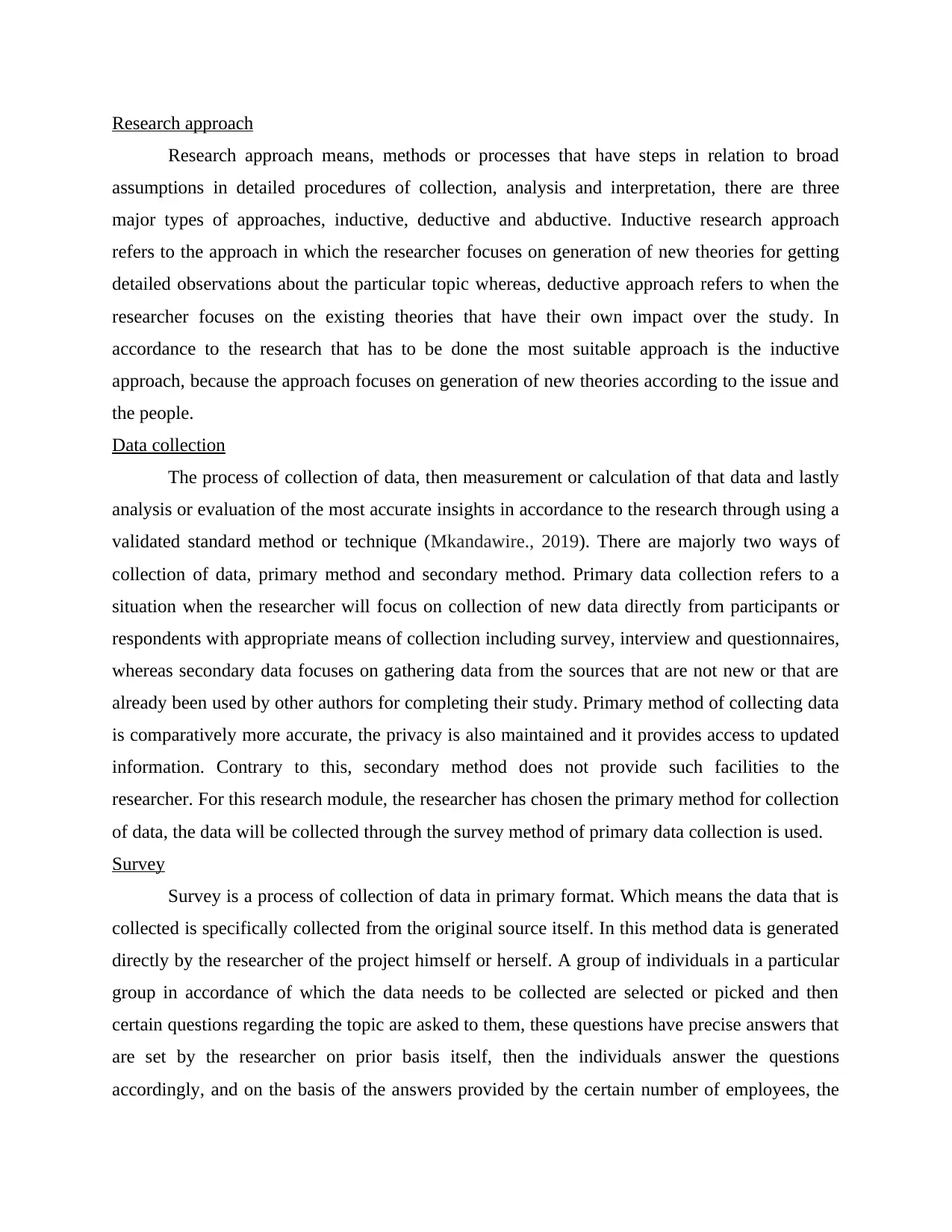
Research approach
Research approach means, methods or processes that have steps in relation to broad
assumptions in detailed procedures of collection, analysis and interpretation, there are three
major types of approaches, inductive, deductive and abductive. Inductive research approach
refers to the approach in which the researcher focuses on generation of new theories for getting
detailed observations about the particular topic whereas, deductive approach refers to when the
researcher focuses on the existing theories that have their own impact over the study. In
accordance to the research that has to be done the most suitable approach is the inductive
approach, because the approach focuses on generation of new theories according to the issue and
the people.
Data collection
The process of collection of data, then measurement or calculation of that data and lastly
analysis or evaluation of the most accurate insights in accordance to the research through using a
validated standard method or technique (Mkandawire., 2019). There are majorly two ways of
collection of data, primary method and secondary method. Primary data collection refers to a
situation when the researcher will focus on collection of new data directly from participants or
respondents with appropriate means of collection including survey, interview and questionnaires,
whereas secondary data focuses on gathering data from the sources that are not new or that are
already been used by other authors for completing their study. Primary method of collecting data
is comparatively more accurate, the privacy is also maintained and it provides access to updated
information. Contrary to this, secondary method does not provide such facilities to the
researcher. For this research module, the researcher has chosen the primary method for collection
of data, the data will be collected through the survey method of primary data collection is used.
Survey
Survey is a process of collection of data in primary format. Which means the data that is
collected is specifically collected from the original source itself. In this method data is generated
directly by the researcher of the project himself or herself. A group of individuals in a particular
group in accordance of which the data needs to be collected are selected or picked and then
certain questions regarding the topic are asked to them, these questions have precise answers that
are set by the researcher on prior basis itself, then the individuals answer the questions
accordingly, and on the basis of the answers provided by the certain number of employees, the
Research approach means, methods or processes that have steps in relation to broad
assumptions in detailed procedures of collection, analysis and interpretation, there are three
major types of approaches, inductive, deductive and abductive. Inductive research approach
refers to the approach in which the researcher focuses on generation of new theories for getting
detailed observations about the particular topic whereas, deductive approach refers to when the
researcher focuses on the existing theories that have their own impact over the study. In
accordance to the research that has to be done the most suitable approach is the inductive
approach, because the approach focuses on generation of new theories according to the issue and
the people.
Data collection
The process of collection of data, then measurement or calculation of that data and lastly
analysis or evaluation of the most accurate insights in accordance to the research through using a
validated standard method or technique (Mkandawire., 2019). There are majorly two ways of
collection of data, primary method and secondary method. Primary data collection refers to a
situation when the researcher will focus on collection of new data directly from participants or
respondents with appropriate means of collection including survey, interview and questionnaires,
whereas secondary data focuses on gathering data from the sources that are not new or that are
already been used by other authors for completing their study. Primary method of collecting data
is comparatively more accurate, the privacy is also maintained and it provides access to updated
information. Contrary to this, secondary method does not provide such facilities to the
researcher. For this research module, the researcher has chosen the primary method for collection
of data, the data will be collected through the survey method of primary data collection is used.
Survey
Survey is a process of collection of data in primary format. Which means the data that is
collected is specifically collected from the original source itself. In this method data is generated
directly by the researcher of the project himself or herself. A group of individuals in a particular
group in accordance of which the data needs to be collected are selected or picked and then
certain questions regarding the topic are asked to them, these questions have precise answers that
are set by the researcher on prior basis itself, then the individuals answer the questions
accordingly, and on the basis of the answers provided by the certain number of employees, the
Paraphrase This Document
Need a fresh take? Get an instant paraphrase of this document with our AI Paraphraser
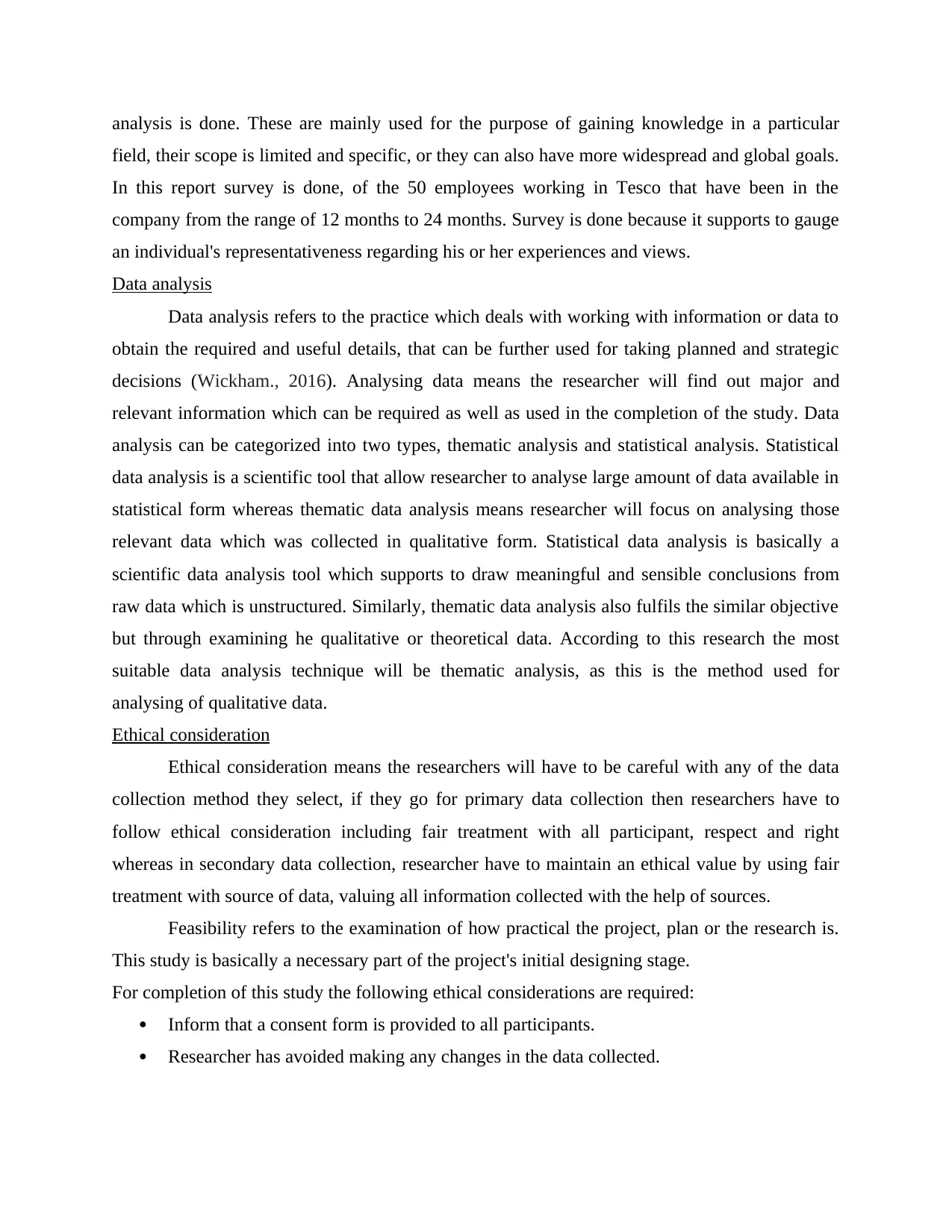
analysis is done. These are mainly used for the purpose of gaining knowledge in a particular
field, their scope is limited and specific, or they can also have more widespread and global goals.
In this report survey is done, of the 50 employees working in Tesco that have been in the
company from the range of 12 months to 24 months. Survey is done because it supports to gauge
an individual's representativeness regarding his or her experiences and views.
Data analysis
Data analysis refers to the practice which deals with working with information or data to
obtain the required and useful details, that can be further used for taking planned and strategic
decisions (Wickham., 2016). Analysing data means the researcher will find out major and
relevant information which can be required as well as used in the completion of the study. Data
analysis can be categorized into two types, thematic analysis and statistical analysis. Statistical
data analysis is a scientific tool that allow researcher to analyse large amount of data available in
statistical form whereas thematic data analysis means researcher will focus on analysing those
relevant data which was collected in qualitative form. Statistical data analysis is basically a
scientific data analysis tool which supports to draw meaningful and sensible conclusions from
raw data which is unstructured. Similarly, thematic data analysis also fulfils the similar objective
but through examining he qualitative or theoretical data. According to this research the most
suitable data analysis technique will be thematic analysis, as this is the method used for
analysing of qualitative data.
Ethical consideration
Ethical consideration means the researchers will have to be careful with any of the data
collection method they select, if they go for primary data collection then researchers have to
follow ethical consideration including fair treatment with all participant, respect and right
whereas in secondary data collection, researcher have to maintain an ethical value by using fair
treatment with source of data, valuing all information collected with the help of sources.
Feasibility refers to the examination of how practical the project, plan or the research is.
This study is basically a necessary part of the project's initial designing stage.
For completion of this study the following ethical considerations are required:
Inform that a consent form is provided to all participants.
Researcher has avoided making any changes in the data collected.
field, their scope is limited and specific, or they can also have more widespread and global goals.
In this report survey is done, of the 50 employees working in Tesco that have been in the
company from the range of 12 months to 24 months. Survey is done because it supports to gauge
an individual's representativeness regarding his or her experiences and views.
Data analysis
Data analysis refers to the practice which deals with working with information or data to
obtain the required and useful details, that can be further used for taking planned and strategic
decisions (Wickham., 2016). Analysing data means the researcher will find out major and
relevant information which can be required as well as used in the completion of the study. Data
analysis can be categorized into two types, thematic analysis and statistical analysis. Statistical
data analysis is a scientific tool that allow researcher to analyse large amount of data available in
statistical form whereas thematic data analysis means researcher will focus on analysing those
relevant data which was collected in qualitative form. Statistical data analysis is basically a
scientific data analysis tool which supports to draw meaningful and sensible conclusions from
raw data which is unstructured. Similarly, thematic data analysis also fulfils the similar objective
but through examining he qualitative or theoretical data. According to this research the most
suitable data analysis technique will be thematic analysis, as this is the method used for
analysing of qualitative data.
Ethical consideration
Ethical consideration means the researchers will have to be careful with any of the data
collection method they select, if they go for primary data collection then researchers have to
follow ethical consideration including fair treatment with all participant, respect and right
whereas in secondary data collection, researcher have to maintain an ethical value by using fair
treatment with source of data, valuing all information collected with the help of sources.
Feasibility refers to the examination of how practical the project, plan or the research is.
This study is basically a necessary part of the project's initial designing stage.
For completion of this study the following ethical considerations are required:
Inform that a consent form is provided to all participants.
Researcher has avoided making any changes in the data collected.
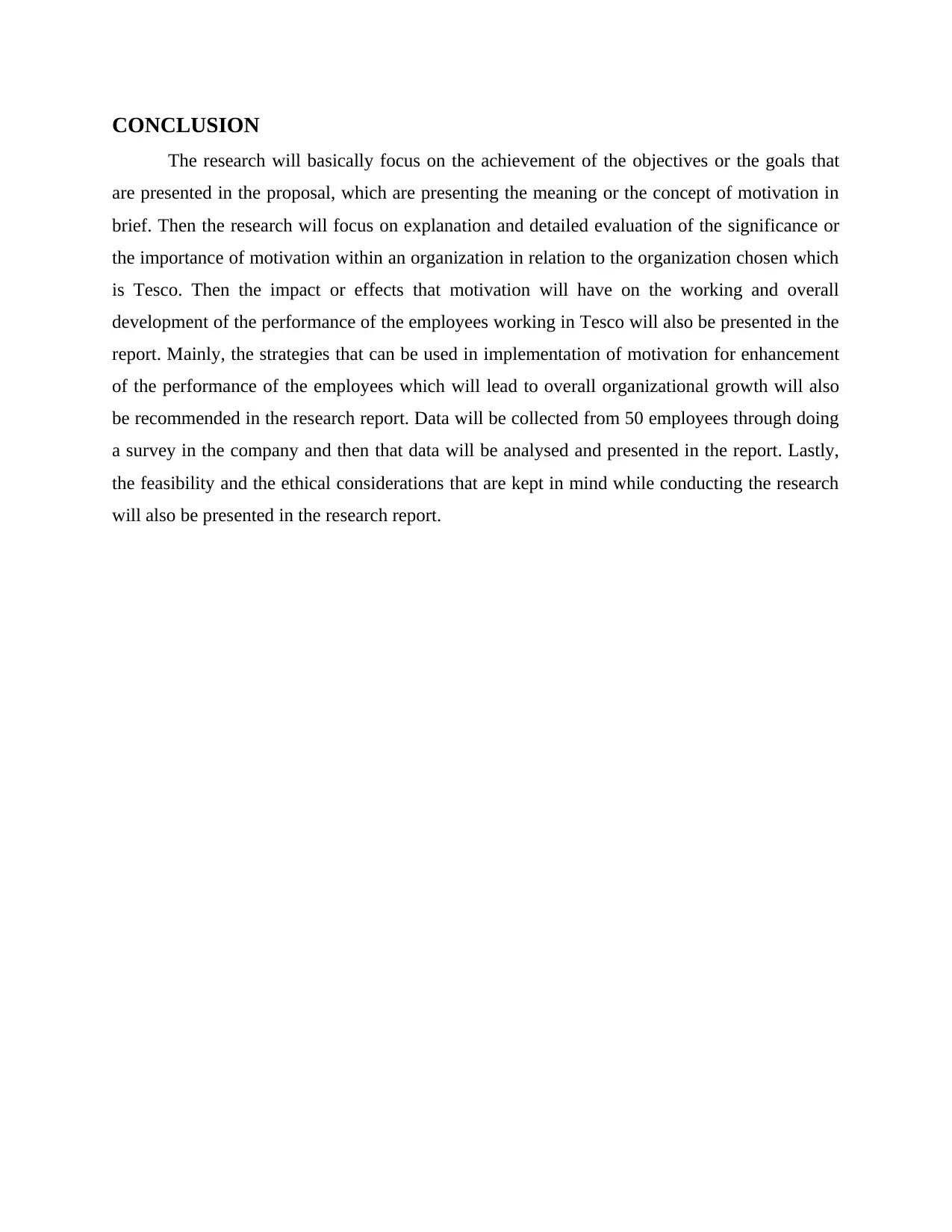
CONCLUSION
The research will basically focus on the achievement of the objectives or the goals that
are presented in the proposal, which are presenting the meaning or the concept of motivation in
brief. Then the research will focus on explanation and detailed evaluation of the significance or
the importance of motivation within an organization in relation to the organization chosen which
is Tesco. Then the impact or effects that motivation will have on the working and overall
development of the performance of the employees working in Tesco will also be presented in the
report. Mainly, the strategies that can be used in implementation of motivation for enhancement
of the performance of the employees which will lead to overall organizational growth will also
be recommended in the research report. Data will be collected from 50 employees through doing
a survey in the company and then that data will be analysed and presented in the report. Lastly,
the feasibility and the ethical considerations that are kept in mind while conducting the research
will also be presented in the research report.
The research will basically focus on the achievement of the objectives or the goals that
are presented in the proposal, which are presenting the meaning or the concept of motivation in
brief. Then the research will focus on explanation and detailed evaluation of the significance or
the importance of motivation within an organization in relation to the organization chosen which
is Tesco. Then the impact or effects that motivation will have on the working and overall
development of the performance of the employees working in Tesco will also be presented in the
report. Mainly, the strategies that can be used in implementation of motivation for enhancement
of the performance of the employees which will lead to overall organizational growth will also
be recommended in the research report. Data will be collected from 50 employees through doing
a survey in the company and then that data will be analysed and presented in the report. Lastly,
the feasibility and the ethical considerations that are kept in mind while conducting the research
will also be presented in the research report.
⊘ This is a preview!⊘
Do you want full access?
Subscribe today to unlock all pages.

Trusted by 1+ million students worldwide
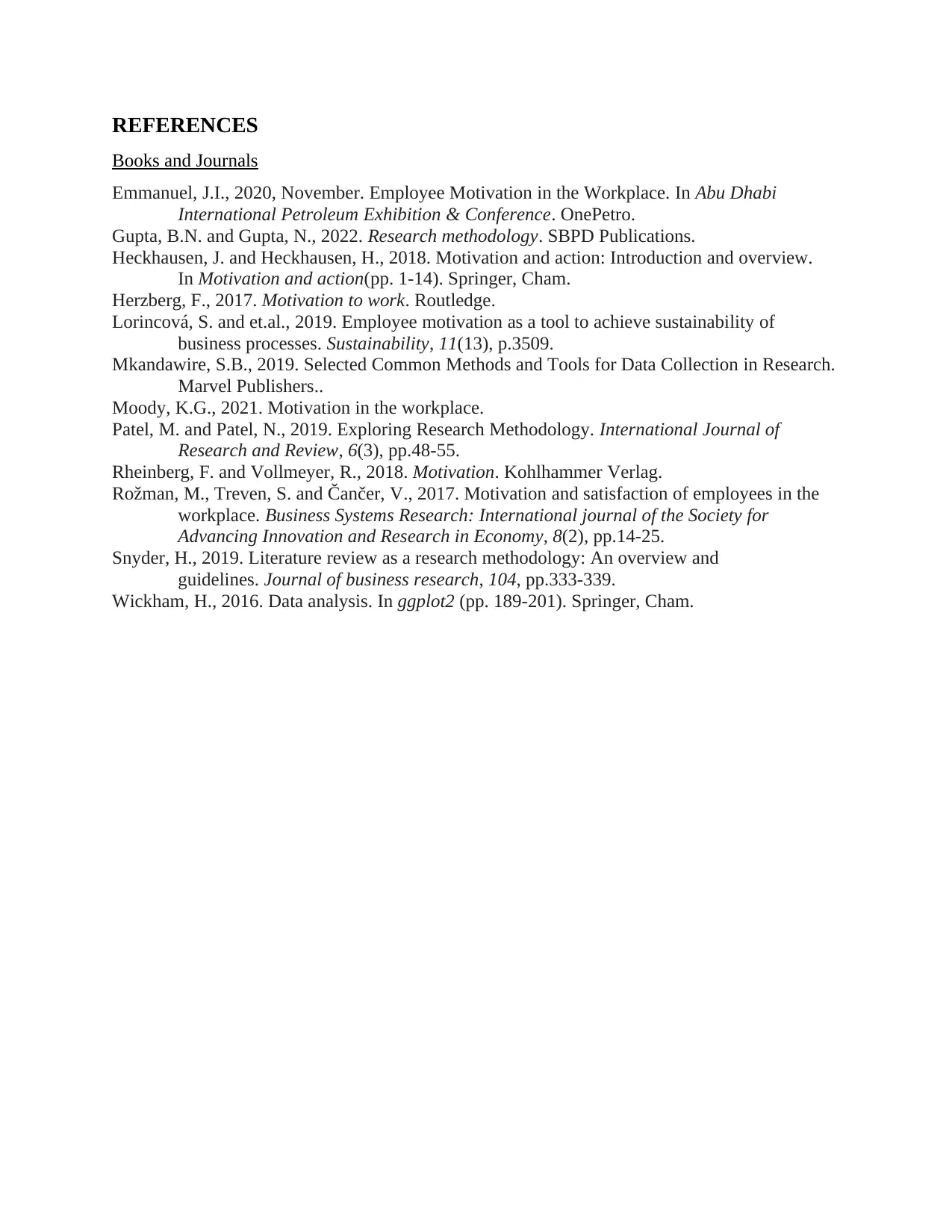
REFERENCES
Books and Journals
Emmanuel, J.I., 2020, November. Employee Motivation in the Workplace. In Abu Dhabi
International Petroleum Exhibition & Conference. OnePetro.
Gupta, B.N. and Gupta, N., 2022. Research methodology. SBPD Publications.
Heckhausen, J. and Heckhausen, H., 2018. Motivation and action: Introduction and overview.
In Motivation and action(pp. 1-14). Springer, Cham.
Herzberg, F., 2017. Motivation to work. Routledge.
Lorincová, S. and et.al., 2019. Employee motivation as a tool to achieve sustainability of
business processes. Sustainability, 11(13), p.3509.
Mkandawire, S.B., 2019. Selected Common Methods and Tools for Data Collection in Research.
Marvel Publishers..
Moody, K.G., 2021. Motivation in the workplace.
Patel, M. and Patel, N., 2019. Exploring Research Methodology. International Journal of
Research and Review, 6(3), pp.48-55.
Rheinberg, F. and Vollmeyer, R., 2018. Motivation. Kohlhammer Verlag.
Rožman, M., Treven, S. and Čančer, V., 2017. Motivation and satisfaction of employees in the
workplace. Business Systems Research: International journal of the Society for
Advancing Innovation and Research in Economy, 8(2), pp.14-25.
Snyder, H., 2019. Literature review as a research methodology: An overview and
guidelines. Journal of business research, 104, pp.333-339.
Wickham, H., 2016. Data analysis. In ggplot2 (pp. 189-201). Springer, Cham.
Books and Journals
Emmanuel, J.I., 2020, November. Employee Motivation in the Workplace. In Abu Dhabi
International Petroleum Exhibition & Conference. OnePetro.
Gupta, B.N. and Gupta, N., 2022. Research methodology. SBPD Publications.
Heckhausen, J. and Heckhausen, H., 2018. Motivation and action: Introduction and overview.
In Motivation and action(pp. 1-14). Springer, Cham.
Herzberg, F., 2017. Motivation to work. Routledge.
Lorincová, S. and et.al., 2019. Employee motivation as a tool to achieve sustainability of
business processes. Sustainability, 11(13), p.3509.
Mkandawire, S.B., 2019. Selected Common Methods and Tools for Data Collection in Research.
Marvel Publishers..
Moody, K.G., 2021. Motivation in the workplace.
Patel, M. and Patel, N., 2019. Exploring Research Methodology. International Journal of
Research and Review, 6(3), pp.48-55.
Rheinberg, F. and Vollmeyer, R., 2018. Motivation. Kohlhammer Verlag.
Rožman, M., Treven, S. and Čančer, V., 2017. Motivation and satisfaction of employees in the
workplace. Business Systems Research: International journal of the Society for
Advancing Innovation and Research in Economy, 8(2), pp.14-25.
Snyder, H., 2019. Literature review as a research methodology: An overview and
guidelines. Journal of business research, 104, pp.333-339.
Wickham, H., 2016. Data analysis. In ggplot2 (pp. 189-201). Springer, Cham.
1 out of 10
Related Documents
Your All-in-One AI-Powered Toolkit for Academic Success.
+13062052269
info@desklib.com
Available 24*7 on WhatsApp / Email
![[object Object]](/_next/static/media/star-bottom.7253800d.svg)
Unlock your academic potential
Copyright © 2020–2025 A2Z Services. All Rights Reserved. Developed and managed by ZUCOL.





